Gender Socialization, Sociological Concepts, and Social Stratification
VerifiedAdded on 2020/01/28
|7
|2194
|218
Essay
AI Summary
This essay delves into the concept of gender socialization, examining how societal norms and cultural influences shape the roles and behaviors of males and females. It explores various sociological concepts, including society culture, social structure, and inequality, and their impact on gender socialization. The essay uses the animated film Zootopia as a case study to illustrate issues of social stratification, prejudice, and bias, highlighting how the movie tackles complex sociopolitical aspects. It discusses the movie's depiction of a seemingly post-racial society and analyzes the portrayal of in-groups and out-groups, as well as the historical roots of fear and prejudice. Furthermore, the essay connects these concepts to broader theories of social stratification, examining class structures and inequality within society, drawing on the theories of Karl Marx and functionalist perspectives. The conclusion emphasizes the significant influence of gender socialization on social culture and the impact of socialization on gender differences, often outweighing biological factors.

Gender socialization
1
1
Paraphrase This Document
Need a fresh take? Get an instant paraphrase of this document with our AI Paraphraser
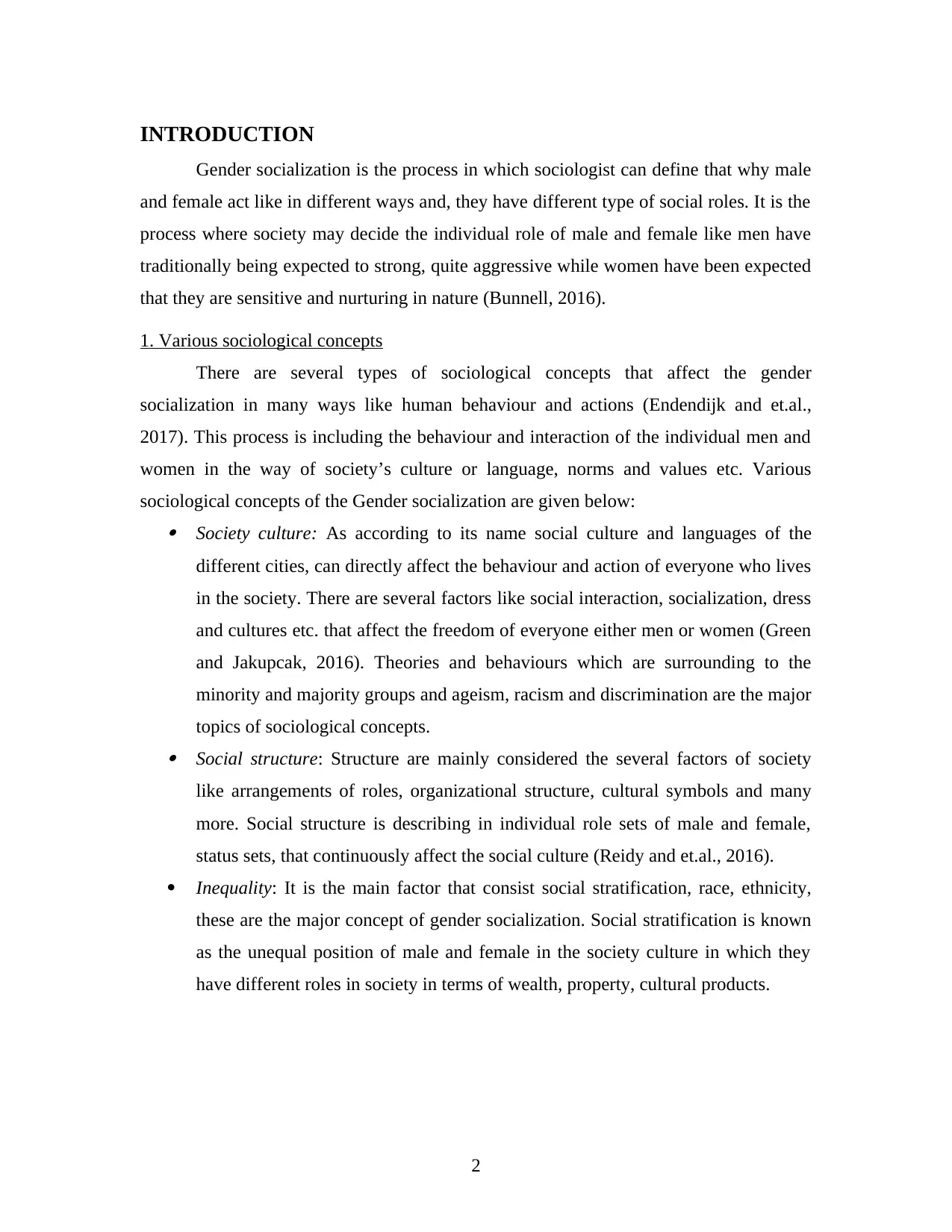
INTRODUCTION
Gender socialization is the process in which sociologist can define that why male
and female act like in different ways and, they have different type of social roles. It is the
process where society may decide the individual role of male and female like men have
traditionally being expected to strong, quite aggressive while women have been expected
that they are sensitive and nurturing in nature (Bunnell, 2016).
1. Various sociological concepts
There are several types of sociological concepts that affect the gender
socialization in many ways like human behaviour and actions (Endendijk and et.al.,
2017). This process is including the behaviour and interaction of the individual men and
women in the way of society’s culture or language, norms and values etc. Various
sociological concepts of the Gender socialization are given below:
Society culture: As according to its name social culture and languages of the
different cities, can directly affect the behaviour and action of everyone who lives
in the society. There are several factors like social interaction, socialization, dress
and cultures etc. that affect the freedom of everyone either men or women (Green
and Jakupcak, 2016). Theories and behaviours which are surrounding to the
minority and majority groups and ageism, racism and discrimination are the major
topics of sociological concepts.
Social structure: Structure are mainly considered the several factors of society
like arrangements of roles, organizational structure, cultural symbols and many
more. Social structure is describing in individual role sets of male and female,
status sets, that continuously affect the social culture (Reidy and et.al., 2016).
Inequality: It is the main factor that consist social stratification, race, ethnicity,
these are the major concept of gender socialization. Social stratification is known
as the unequal position of male and female in the society culture in which they
have different roles in society in terms of wealth, property, cultural products.
2
Gender socialization is the process in which sociologist can define that why male
and female act like in different ways and, they have different type of social roles. It is the
process where society may decide the individual role of male and female like men have
traditionally being expected to strong, quite aggressive while women have been expected
that they are sensitive and nurturing in nature (Bunnell, 2016).
1. Various sociological concepts
There are several types of sociological concepts that affect the gender
socialization in many ways like human behaviour and actions (Endendijk and et.al.,
2017). This process is including the behaviour and interaction of the individual men and
women in the way of society’s culture or language, norms and values etc. Various
sociological concepts of the Gender socialization are given below:
Society culture: As according to its name social culture and languages of the
different cities, can directly affect the behaviour and action of everyone who lives
in the society. There are several factors like social interaction, socialization, dress
and cultures etc. that affect the freedom of everyone either men or women (Green
and Jakupcak, 2016). Theories and behaviours which are surrounding to the
minority and majority groups and ageism, racism and discrimination are the major
topics of sociological concepts.
Social structure: Structure are mainly considered the several factors of society
like arrangements of roles, organizational structure, cultural symbols and many
more. Social structure is describing in individual role sets of male and female,
status sets, that continuously affect the social culture (Reidy and et.al., 2016).
Inequality: It is the main factor that consist social stratification, race, ethnicity,
these are the major concept of gender socialization. Social stratification is known
as the unequal position of male and female in the society culture in which they
have different roles in society in terms of wealth, property, cultural products.
2
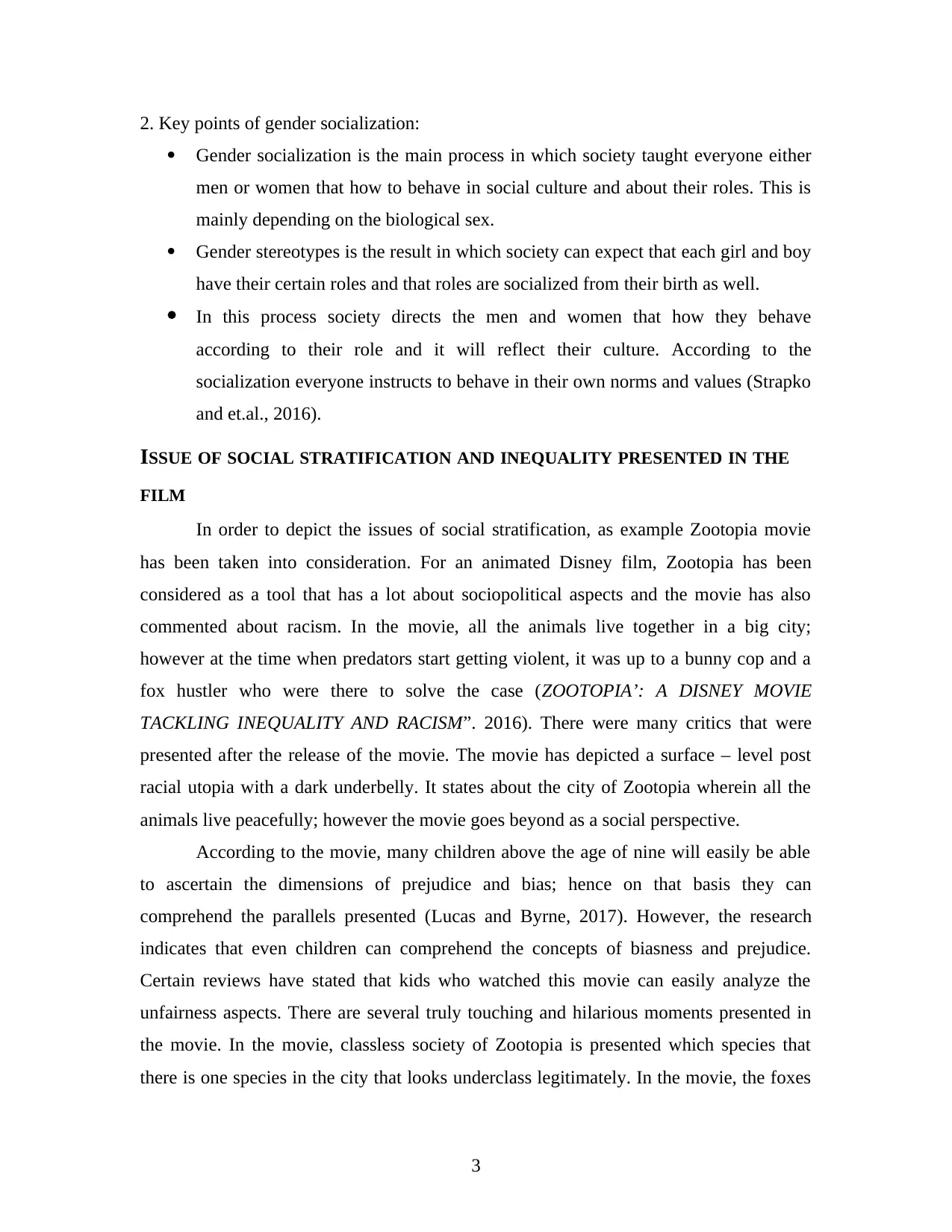
2. Key points of gender socialization:
Gender socialization is the main process in which society taught everyone either
men or women that how to behave in social culture and about their roles. This is
mainly depending on the biological sex.
Gender stereotypes is the result in which society can expect that each girl and boy
have their certain roles and that roles are socialized from their birth as well.
In this process society directs the men and women that how they behave
according to their role and it will reflect their culture. According to the
socialization everyone instructs to behave in their own norms and values (Strapko
and et.al., 2016).
ISSUE OF SOCIAL STRATIFICATION AND INEQUALITY PRESENTED IN THE
FILM
In order to depict the issues of social stratification, as example Zootopia movie
has been taken into consideration. For an animated Disney film, Zootopia has been
considered as a tool that has a lot about sociopolitical aspects and the movie has also
commented about racism. In the movie, all the animals live together in a big city;
however at the time when predators start getting violent, it was up to a bunny cop and a
fox hustler who were there to solve the case (ZOOTOPIA’: A DISNEY MOVIE
TACKLING INEQUALITY AND RACISM”. 2016). There were many critics that were
presented after the release of the movie. The movie has depicted a surface – level post
racial utopia with a dark underbelly. It states about the city of Zootopia wherein all the
animals live peacefully; however the movie goes beyond as a social perspective.
According to the movie, many children above the age of nine will easily be able
to ascertain the dimensions of prejudice and bias; hence on that basis they can
comprehend the parallels presented (Lucas and Byrne, 2017). However, the research
indicates that even children can comprehend the concepts of biasness and prejudice.
Certain reviews have stated that kids who watched this movie can easily analyze the
unfairness aspects. There are several truly touching and hilarious moments presented in
the movie. In the movie, classless society of Zootopia is presented which species that
there is one species in the city that looks underclass legitimately. In the movie, the foxes
3
Gender socialization is the main process in which society taught everyone either
men or women that how to behave in social culture and about their roles. This is
mainly depending on the biological sex.
Gender stereotypes is the result in which society can expect that each girl and boy
have their certain roles and that roles are socialized from their birth as well.
In this process society directs the men and women that how they behave
according to their role and it will reflect their culture. According to the
socialization everyone instructs to behave in their own norms and values (Strapko
and et.al., 2016).
ISSUE OF SOCIAL STRATIFICATION AND INEQUALITY PRESENTED IN THE
FILM
In order to depict the issues of social stratification, as example Zootopia movie
has been taken into consideration. For an animated Disney film, Zootopia has been
considered as a tool that has a lot about sociopolitical aspects and the movie has also
commented about racism. In the movie, all the animals live together in a big city;
however at the time when predators start getting violent, it was up to a bunny cop and a
fox hustler who were there to solve the case (ZOOTOPIA’: A DISNEY MOVIE
TACKLING INEQUALITY AND RACISM”. 2016). There were many critics that were
presented after the release of the movie. The movie has depicted a surface – level post
racial utopia with a dark underbelly. It states about the city of Zootopia wherein all the
animals live peacefully; however the movie goes beyond as a social perspective.
According to the movie, many children above the age of nine will easily be able
to ascertain the dimensions of prejudice and bias; hence on that basis they can
comprehend the parallels presented (Lucas and Byrne, 2017). However, the research
indicates that even children can comprehend the concepts of biasness and prejudice.
Certain reviews have stated that kids who watched this movie can easily analyze the
unfairness aspects. There are several truly touching and hilarious moments presented in
the movie. In the movie, classless society of Zootopia is presented which species that
there is one species in the city that looks underclass legitimately. In the movie, the foxes
3
⊘ This is a preview!⊘
Do you want full access?
Subscribe today to unlock all pages.

Trusted by 1+ million students worldwide
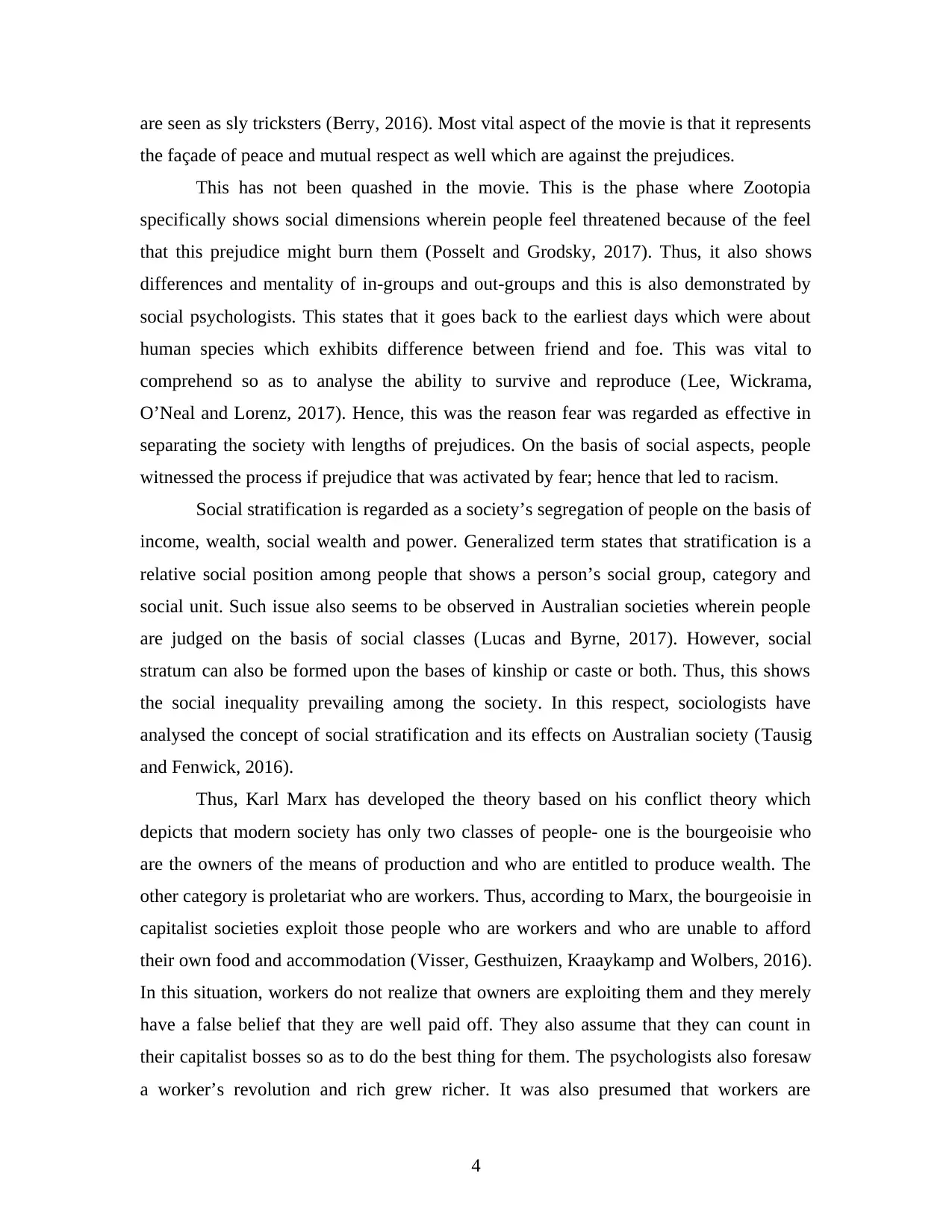
are seen as sly tricksters (Berry, 2016). Most vital aspect of the movie is that it represents
the façade of peace and mutual respect as well which are against the prejudices.
This has not been quashed in the movie. This is the phase where Zootopia
specifically shows social dimensions wherein people feel threatened because of the feel
that this prejudice might burn them (Posselt and Grodsky, 2017). Thus, it also shows
differences and mentality of in-groups and out-groups and this is also demonstrated by
social psychologists. This states that it goes back to the earliest days which were about
human species which exhibits difference between friend and foe. This was vital to
comprehend so as to analyse the ability to survive and reproduce (Lee, Wickrama,
O’Neal and Lorenz, 2017). Hence, this was the reason fear was regarded as effective in
separating the society with lengths of prejudices. On the basis of social aspects, people
witnessed the process if prejudice that was activated by fear; hence that led to racism.
Social stratification is regarded as a society’s segregation of people on the basis of
income, wealth, social wealth and power. Generalized term states that stratification is a
relative social position among people that shows a person’s social group, category and
social unit. Such issue also seems to be observed in Australian societies wherein people
are judged on the basis of social classes (Lucas and Byrne, 2017). However, social
stratum can also be formed upon the bases of kinship or caste or both. Thus, this shows
the social inequality prevailing among the society. In this respect, sociologists have
analysed the concept of social stratification and its effects on Australian society (Tausig
and Fenwick, 2016).
Thus, Karl Marx has developed the theory based on his conflict theory which
depicts that modern society has only two classes of people- one is the bourgeoisie who
are the owners of the means of production and who are entitled to produce wealth. The
other category is proletariat who are workers. Thus, according to Marx, the bourgeoisie in
capitalist societies exploit those people who are workers and who are unable to afford
their own food and accommodation (Visser, Gesthuizen, Kraaykamp and Wolbers, 2016).
In this situation, workers do not realize that owners are exploiting them and they merely
have a false belief that they are well paid off. They also assume that they can count in
their capitalist bosses so as to do the best thing for them. The psychologists also foresaw
a worker’s revolution and rich grew richer. It was also presumed that workers are
4
the façade of peace and mutual respect as well which are against the prejudices.
This has not been quashed in the movie. This is the phase where Zootopia
specifically shows social dimensions wherein people feel threatened because of the feel
that this prejudice might burn them (Posselt and Grodsky, 2017). Thus, it also shows
differences and mentality of in-groups and out-groups and this is also demonstrated by
social psychologists. This states that it goes back to the earliest days which were about
human species which exhibits difference between friend and foe. This was vital to
comprehend so as to analyse the ability to survive and reproduce (Lee, Wickrama,
O’Neal and Lorenz, 2017). Hence, this was the reason fear was regarded as effective in
separating the society with lengths of prejudices. On the basis of social aspects, people
witnessed the process if prejudice that was activated by fear; hence that led to racism.
Social stratification is regarded as a society’s segregation of people on the basis of
income, wealth, social wealth and power. Generalized term states that stratification is a
relative social position among people that shows a person’s social group, category and
social unit. Such issue also seems to be observed in Australian societies wherein people
are judged on the basis of social classes (Lucas and Byrne, 2017). However, social
stratum can also be formed upon the bases of kinship or caste or both. Thus, this shows
the social inequality prevailing among the society. In this respect, sociologists have
analysed the concept of social stratification and its effects on Australian society (Tausig
and Fenwick, 2016).
Thus, Karl Marx has developed the theory based on his conflict theory which
depicts that modern society has only two classes of people- one is the bourgeoisie who
are the owners of the means of production and who are entitled to produce wealth. The
other category is proletariat who are workers. Thus, according to Marx, the bourgeoisie in
capitalist societies exploit those people who are workers and who are unable to afford
their own food and accommodation (Visser, Gesthuizen, Kraaykamp and Wolbers, 2016).
In this situation, workers do not realize that owners are exploiting them and they merely
have a false belief that they are well paid off. They also assume that they can count in
their capitalist bosses so as to do the best thing for them. The psychologists also foresaw
a worker’s revolution and rich grew richer. It was also presumed that workers are
4
Paraphrase This Document
Need a fresh take? Get an instant paraphrase of this document with our AI Paraphraser
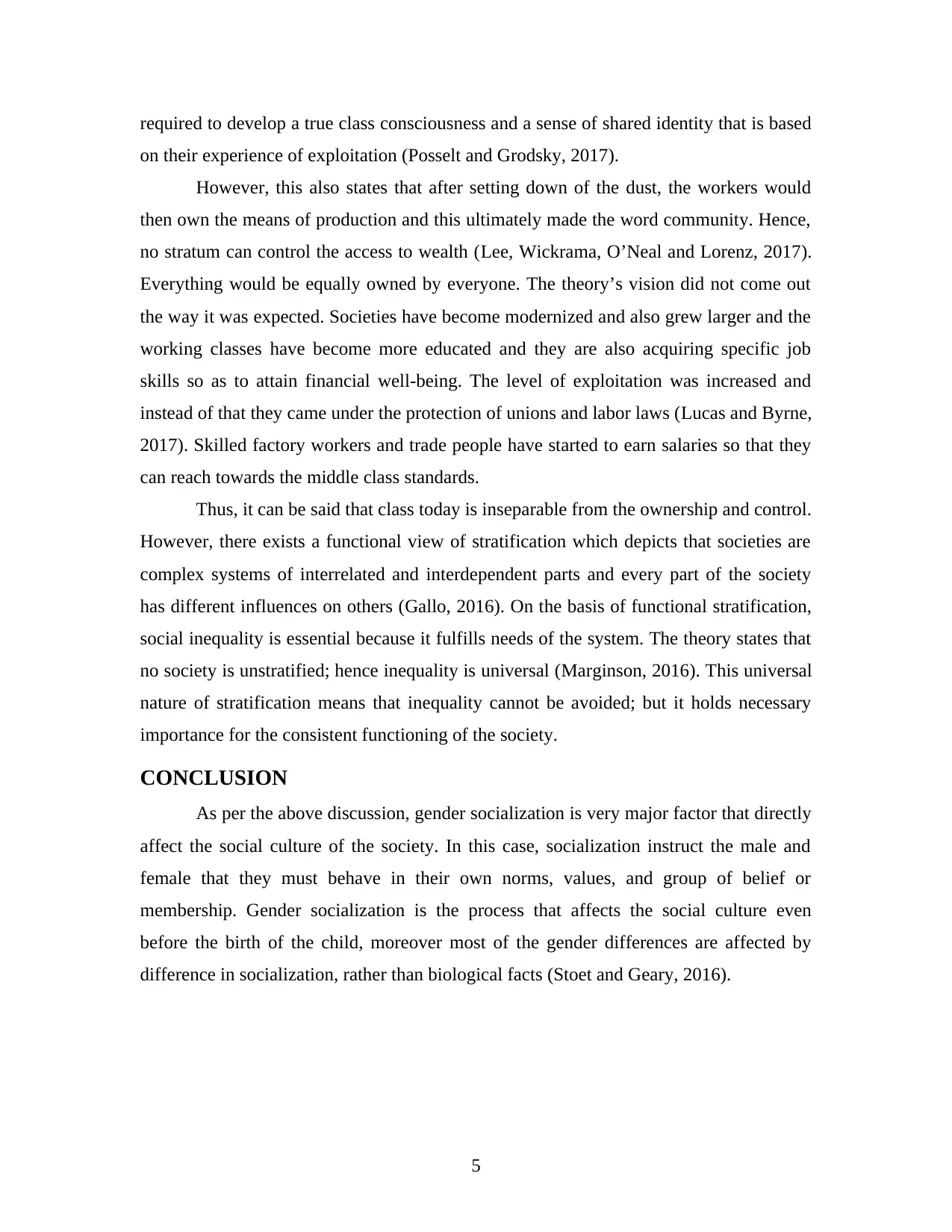
required to develop a true class consciousness and a sense of shared identity that is based
on their experience of exploitation (Posselt and Grodsky, 2017).
However, this also states that after setting down of the dust, the workers would
then own the means of production and this ultimately made the word community. Hence,
no stratum can control the access to wealth (Lee, Wickrama, O’Neal and Lorenz, 2017).
Everything would be equally owned by everyone. The theory’s vision did not come out
the way it was expected. Societies have become modernized and also grew larger and the
working classes have become more educated and they are also acquiring specific job
skills so as to attain financial well-being. The level of exploitation was increased and
instead of that they came under the protection of unions and labor laws (Lucas and Byrne,
2017). Skilled factory workers and trade people have started to earn salaries so that they
can reach towards the middle class standards.
Thus, it can be said that class today is inseparable from the ownership and control.
However, there exists a functional view of stratification which depicts that societies are
complex systems of interrelated and interdependent parts and every part of the society
has different influences on others (Gallo, 2016). On the basis of functional stratification,
social inequality is essential because it fulfills needs of the system. The theory states that
no society is unstratified; hence inequality is universal (Marginson, 2016). This universal
nature of stratification means that inequality cannot be avoided; but it holds necessary
importance for the consistent functioning of the society.
CONCLUSION
As per the above discussion, gender socialization is very major factor that directly
affect the social culture of the society. In this case, socialization instruct the male and
female that they must behave in their own norms, values, and group of belief or
membership. Gender socialization is the process that affects the social culture even
before the birth of the child, moreover most of the gender differences are affected by
difference in socialization, rather than biological facts (Stoet and Geary, 2016).
5
on their experience of exploitation (Posselt and Grodsky, 2017).
However, this also states that after setting down of the dust, the workers would
then own the means of production and this ultimately made the word community. Hence,
no stratum can control the access to wealth (Lee, Wickrama, O’Neal and Lorenz, 2017).
Everything would be equally owned by everyone. The theory’s vision did not come out
the way it was expected. Societies have become modernized and also grew larger and the
working classes have become more educated and they are also acquiring specific job
skills so as to attain financial well-being. The level of exploitation was increased and
instead of that they came under the protection of unions and labor laws (Lucas and Byrne,
2017). Skilled factory workers and trade people have started to earn salaries so that they
can reach towards the middle class standards.
Thus, it can be said that class today is inseparable from the ownership and control.
However, there exists a functional view of stratification which depicts that societies are
complex systems of interrelated and interdependent parts and every part of the society
has different influences on others (Gallo, 2016). On the basis of functional stratification,
social inequality is essential because it fulfills needs of the system. The theory states that
no society is unstratified; hence inequality is universal (Marginson, 2016). This universal
nature of stratification means that inequality cannot be avoided; but it holds necessary
importance for the consistent functioning of the society.
CONCLUSION
As per the above discussion, gender socialization is very major factor that directly
affect the social culture of the society. In this case, socialization instruct the male and
female that they must behave in their own norms, values, and group of belief or
membership. Gender socialization is the process that affects the social culture even
before the birth of the child, moreover most of the gender differences are affected by
difference in socialization, rather than biological facts (Stoet and Geary, 2016).
5
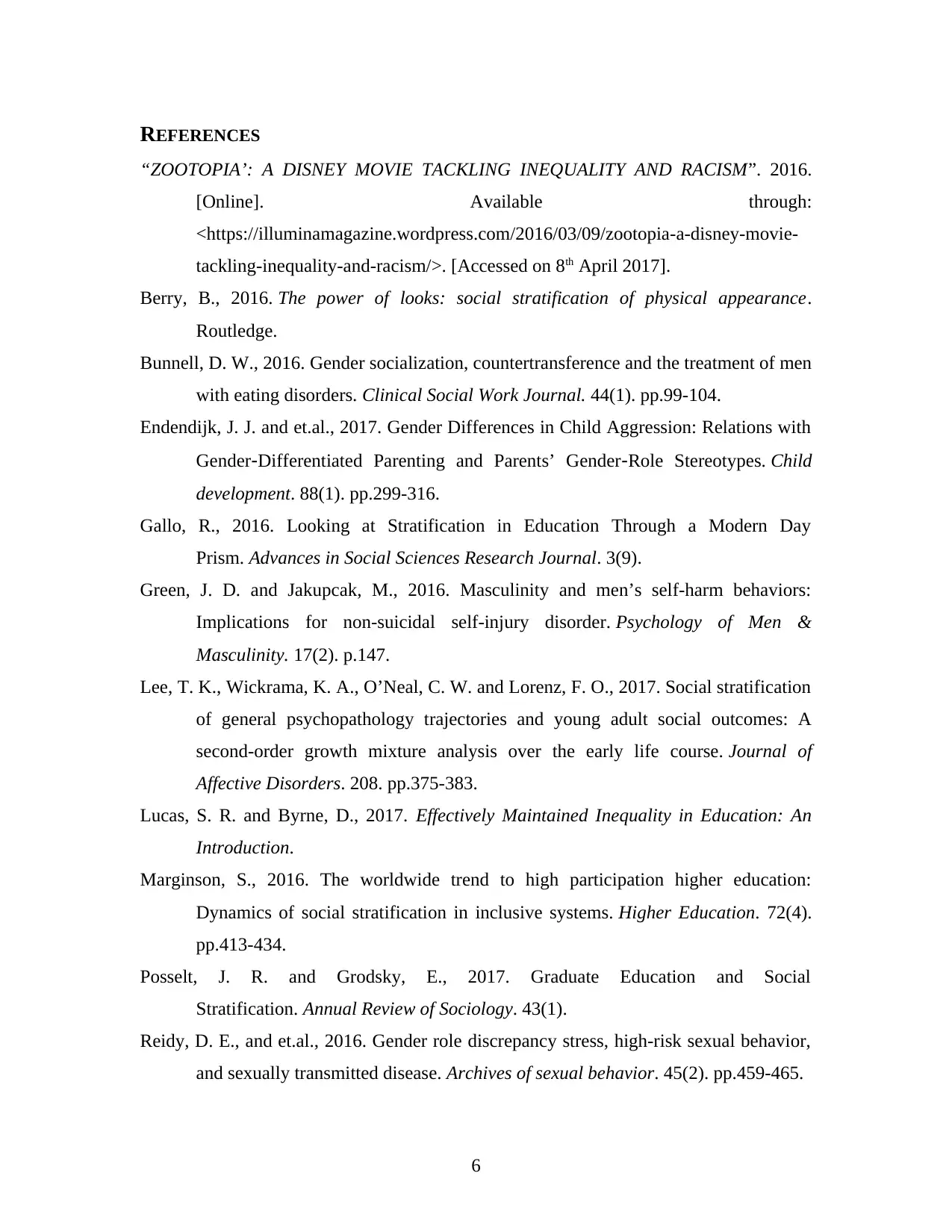
REFERENCES
“ZOOTOPIA’: A DISNEY MOVIE TACKLING INEQUALITY AND RACISM”. 2016.
[Online]. Available through:
<https://illuminamagazine.wordpress.com/2016/03/09/zootopia-a-disney-movie-
tackling-inequality-and-racism/>. [Accessed on 8th April 2017].
Berry, B., 2016. The power of looks: social stratification of physical appearance.
Routledge.
Bunnell, D. W., 2016. Gender socialization, countertransference and the treatment of men
with eating disorders. Clinical Social Work Journal. 44(1). pp.99-104.
Endendijk, J. J. and et.al., 2017. Gender Differences in Child Aggression: Relations with
Gender‐Differentiated Parenting and Parents’ Gender‐Role Stereotypes. Child
development. 88(1). pp.299-316.
Gallo, R., 2016. Looking at Stratification in Education Through a Modern Day
Prism. Advances in Social Sciences Research Journal. 3(9).
Green, J. D. and Jakupcak, M., 2016. Masculinity and men’s self-harm behaviors:
Implications for non-suicidal self-injury disorder. Psychology of Men &
Masculinity. 17(2). p.147.
Lee, T. K., Wickrama, K. A., O’Neal, C. W. and Lorenz, F. O., 2017. Social stratification
of general psychopathology trajectories and young adult social outcomes: A
second-order growth mixture analysis over the early life course. Journal of
Affective Disorders. 208. pp.375-383.
Lucas, S. R. and Byrne, D., 2017. Effectively Maintained Inequality in Education: An
Introduction.
Marginson, S., 2016. The worldwide trend to high participation higher education:
Dynamics of social stratification in inclusive systems. Higher Education. 72(4).
pp.413-434.
Posselt, J. R. and Grodsky, E., 2017. Graduate Education and Social
Stratification. Annual Review of Sociology. 43(1).
Reidy, D. E., and et.al., 2016. Gender role discrepancy stress, high-risk sexual behavior,
and sexually transmitted disease. Archives of sexual behavior. 45(2). pp.459-465.
6
“ZOOTOPIA’: A DISNEY MOVIE TACKLING INEQUALITY AND RACISM”. 2016.
[Online]. Available through:
<https://illuminamagazine.wordpress.com/2016/03/09/zootopia-a-disney-movie-
tackling-inequality-and-racism/>. [Accessed on 8th April 2017].
Berry, B., 2016. The power of looks: social stratification of physical appearance.
Routledge.
Bunnell, D. W., 2016. Gender socialization, countertransference and the treatment of men
with eating disorders. Clinical Social Work Journal. 44(1). pp.99-104.
Endendijk, J. J. and et.al., 2017. Gender Differences in Child Aggression: Relations with
Gender‐Differentiated Parenting and Parents’ Gender‐Role Stereotypes. Child
development. 88(1). pp.299-316.
Gallo, R., 2016. Looking at Stratification in Education Through a Modern Day
Prism. Advances in Social Sciences Research Journal. 3(9).
Green, J. D. and Jakupcak, M., 2016. Masculinity and men’s self-harm behaviors:
Implications for non-suicidal self-injury disorder. Psychology of Men &
Masculinity. 17(2). p.147.
Lee, T. K., Wickrama, K. A., O’Neal, C. W. and Lorenz, F. O., 2017. Social stratification
of general psychopathology trajectories and young adult social outcomes: A
second-order growth mixture analysis over the early life course. Journal of
Affective Disorders. 208. pp.375-383.
Lucas, S. R. and Byrne, D., 2017. Effectively Maintained Inequality in Education: An
Introduction.
Marginson, S., 2016. The worldwide trend to high participation higher education:
Dynamics of social stratification in inclusive systems. Higher Education. 72(4).
pp.413-434.
Posselt, J. R. and Grodsky, E., 2017. Graduate Education and Social
Stratification. Annual Review of Sociology. 43(1).
Reidy, D. E., and et.al., 2016. Gender role discrepancy stress, high-risk sexual behavior,
and sexually transmitted disease. Archives of sexual behavior. 45(2). pp.459-465.
6
⊘ This is a preview!⊘
Do you want full access?
Subscribe today to unlock all pages.

Trusted by 1+ million students worldwide
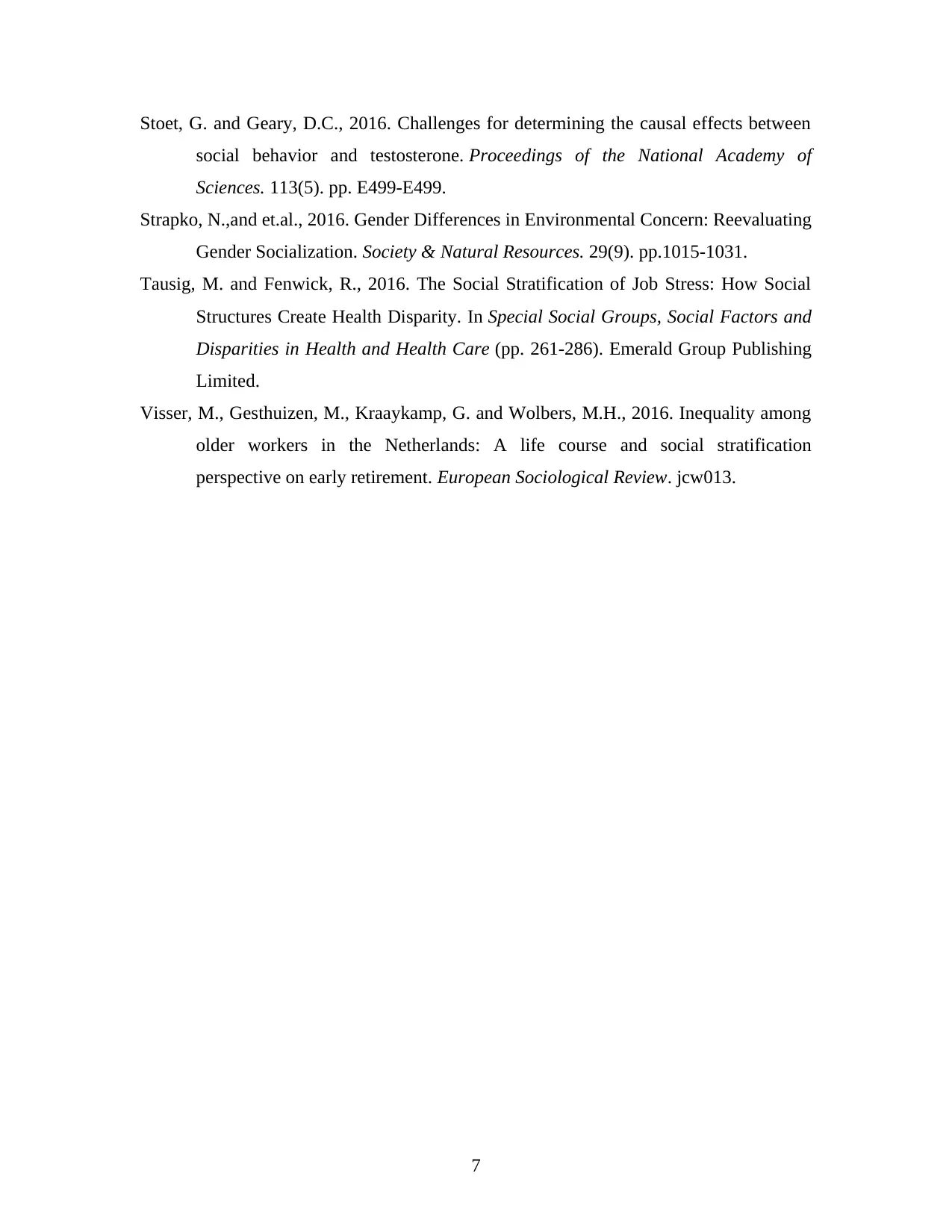
Stoet, G. and Geary, D.C., 2016. Challenges for determining the causal effects between
social behavior and testosterone. Proceedings of the National Academy of
Sciences. 113(5). pp. E499-E499.
Strapko, N.,and et.al., 2016. Gender Differences in Environmental Concern: Reevaluating
Gender Socialization. Society & Natural Resources. 29(9). pp.1015-1031.
Tausig, M. and Fenwick, R., 2016. The Social Stratification of Job Stress: How Social
Structures Create Health Disparity. In Special Social Groups, Social Factors and
Disparities in Health and Health Care (pp. 261-286). Emerald Group Publishing
Limited.
Visser, M., Gesthuizen, M., Kraaykamp, G. and Wolbers, M.H., 2016. Inequality among
older workers in the Netherlands: A life course and social stratification
perspective on early retirement. European Sociological Review. jcw013.
7
social behavior and testosterone. Proceedings of the National Academy of
Sciences. 113(5). pp. E499-E499.
Strapko, N.,and et.al., 2016. Gender Differences in Environmental Concern: Reevaluating
Gender Socialization. Society & Natural Resources. 29(9). pp.1015-1031.
Tausig, M. and Fenwick, R., 2016. The Social Stratification of Job Stress: How Social
Structures Create Health Disparity. In Special Social Groups, Social Factors and
Disparities in Health and Health Care (pp. 261-286). Emerald Group Publishing
Limited.
Visser, M., Gesthuizen, M., Kraaykamp, G. and Wolbers, M.H., 2016. Inequality among
older workers in the Netherlands: A life course and social stratification
perspective on early retirement. European Sociological Review. jcw013.
7
1 out of 7
Related Documents
Your All-in-One AI-Powered Toolkit for Academic Success.
+13062052269
info@desklib.com
Available 24*7 on WhatsApp / Email
![[object Object]](/_next/static/media/star-bottom.7253800d.svg)
Unlock your academic potential
Copyright © 2020–2025 A2Z Services. All Rights Reserved. Developed and managed by ZUCOL.





